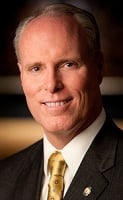Scripps Health will move to a regional model within the next 60 days, eliminating the CEO role at its five hospitals and taking actions to cut its corporate services costs by $30 million.
In an internal memo to staff and physicians last week, Scripps Health President and CEO Chris Van Gorder said that there will now be a chief executive for each region and one executive over ancillary services. The Northern region will include Scripps Encitas, Green and La Jolla. The Southern region includes Scripps Mercy San Diego and Chula Vista campuses.
RELATED: Intermountain Healthcare abandons regional approach to care
Daily operations of hospitals will shift to chief operations executives, who will now report to regional CEOs. The changes will also include reductions its budget for corporate services by $30 million, he said in the memo that FierceHealthcare received late Monday.
The reason for the restructuring: Van Gorder said that in 2016—for the first time in 15 years—the San Diego-based private, nonprofit, integrated health system did not achieve its operating budget. Although the system didn’t lose money and is still financially strong, he said in the document that failure is a “sobering warning of harder times to come.”
Reimbursements are declining and costs continue to rise. As a result, he said, Scripps’ operating income (the actual income minus expenses) over the last five years has dropped.
“If this continues,” he wrote in the memo, “it means we will have less money to fund things like new equipment, salary increases, facility improvements, new construction and more.”
He blamed the decline on changing payer mix and declining reimbursements. Two-thirds of Scripps patients, he said, are covered by Medicare or MediCal, but overall reimbursement for the plans don’t cover the cost of care that Scripps provides. In addition, commercial insurance plans have cut the pay for care the system provides.
Van Gorder noted that Scripps isn’t the only system facing these issues. Partners HealthCare in New England reported an operating loss last year of $108 million. Cleveland Clinic, he said, saw a 71% decline in operating income.
“None of this is pretty,” he said, “but we need to see it as an opportunity to create a different future. We can no longer rely on past models. If the world around us is rapidly changing, we have to stop looking back and start looking forward.”
In addition to the leadership changes, Van Gorder said the system will implement a joint leadership “dyad” model between hospital administrators and physician leaders to align physician and hospital objectives. Furthermore, the organization will redesign its care delivery operations to be patient-centered and as cost efficient as possible.
“The goal,” he told staff in the memo, “is to get out of our silos and work together in entirely new ways to deliver care at a lower cost, with better quality and an exceptional patient experience.”
Moreover, Van Gorder said the system will evaluate a “shared services” model for corporate services that will create more accountability to those at the point of service.
